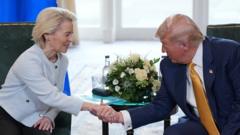The accord, which includes significant commitments from both sides, will likely have profound implications for global trade dynamics moving forward. Trump emphasized the benefits of the agreement, asserting that it would foster closer ties and result in a substantial influx of investments from the EU, totaling around $600 billion. This investment is anticipated to enhance military acquisitions and energy procurement from the U.S., notably lessening European dependence on Russian energy.
Von der Leyen characterized the negotiations as challenging but productive, highlighting the significance of reaching a supportive consensus for both parties. Trump defended his approach to global tariffs, claiming that this deal would ultimately bolster the U.S. economy, projected to generate approximately $90 billion in tariff revenue.
With trade amounts between the EU and U.S. reaching approximately $975.9 billion in the previous year, this agreement reflects a balance of interests aimed at lowering trade barriers while securing mutual economic benefits.
However, both sides still face challenges going forward, as potential retaliatory tariffs from the EU on American goods remain a looming possibility. As Trump navigates his trade strategy, the implications of this agreement could reshape market landscapes on both sides of the Atlantic, potentially influencing future diplomatic and economic engagements globally.
The convergence of interests also precedes upcoming meetings with other allied leaders, including British Prime Minister Keir Starmer, indicating a broader ambition for trade collaboration under the auspices of Trump's administration. The trade realm is poised for evolution as nations recalibrate their approaches amidst these negotiations.
Von der Leyen characterized the negotiations as challenging but productive, highlighting the significance of reaching a supportive consensus for both parties. Trump defended his approach to global tariffs, claiming that this deal would ultimately bolster the U.S. economy, projected to generate approximately $90 billion in tariff revenue.
With trade amounts between the EU and U.S. reaching approximately $975.9 billion in the previous year, this agreement reflects a balance of interests aimed at lowering trade barriers while securing mutual economic benefits.
However, both sides still face challenges going forward, as potential retaliatory tariffs from the EU on American goods remain a looming possibility. As Trump navigates his trade strategy, the implications of this agreement could reshape market landscapes on both sides of the Atlantic, potentially influencing future diplomatic and economic engagements globally.
The convergence of interests also precedes upcoming meetings with other allied leaders, including British Prime Minister Keir Starmer, indicating a broader ambition for trade collaboration under the auspices of Trump's administration. The trade realm is poised for evolution as nations recalibrate their approaches amidst these negotiations.





















